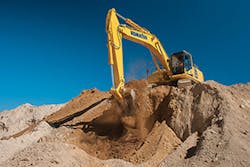Where Is Hydraulics Technology Heading?
Hydraulics technology is more tortoise than hare. Instead of major leaps, it has advanced incrementally and steadily. The base architecture of many of the electro-hydraulic systems we use today have been around for at least 25 years. It’s not that hydraulics in general have taken a leap forward, but rather, they have continued advancing in the three main areas of the hydraulics control system. Joystick (input), actuator (output), and sensor (feedback) technology have matured to a very high level of reliability and cost effectiveness.
Yet, like compound interest, small improvements add up to big changes over time. The most notable changes can be simplified overall design of the hydraulic lines combined with more complicated electronics and computers. This is especially true in excavators, which are far more complicated than other earthmoving equipment. Excavators require more complicated controls to coordinate their movements and ensure efficient operation, and also simplicity of design to minimize maintenance and operating costs.
The effects of technological improvements on the human element should not be ignored. The advancement of hydraulics over the last 20 years or so can be first noticed by the operator in ease of operation. Reduction in operator fatigue and “ease of use” has been a large driver behind many of the advancements hydraulic systems use today. The first hydraulic system to accomplish both greater efficiency and greater ease of use was the pressure compensated load-sensing (PCLS) system. This reduced operator fatigue by making the balancing act of multi-function metering much easier. In the old days, balancing the speed of multi-functions was accomplished by a highly skilled operator. It was a juggling act to keep all the functions moving to make a flat trench or cut a level grade. The introduction of pressure compensation made the flow matching all internal to the valve. The operator still had to pick the right speed, so to say, but from there the speed would not change based on load.










